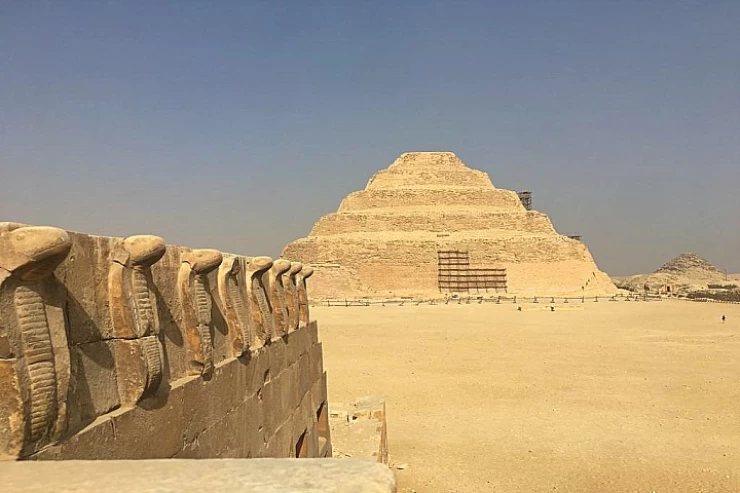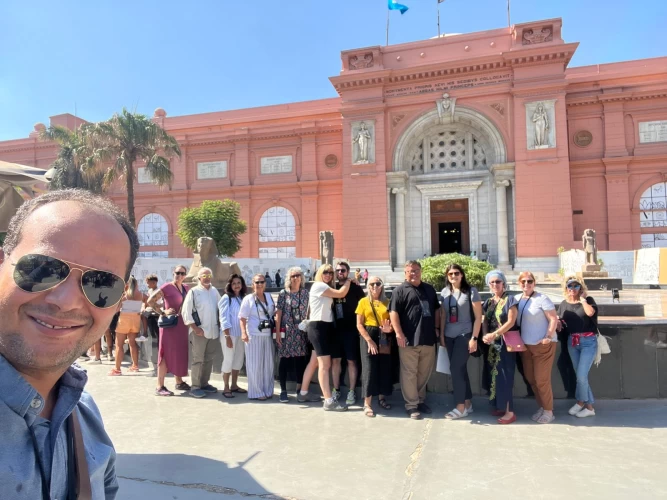
Las pirámides de Giza

Las pirámides egipcias son estructuras del antiguo Egipto en forma de pirámides. Desde noviembre de 2008, las fuentes han estimado el número de pirámides egipcias en unas 118 o 138. Durante la antigüedad y la Edad Media, la mayoría de ellas fueron construidas como tumbas para los antiguos faraones y sus dependientes.
Las pirámides egipcias más antiguas conocidas se encuentran en Saqqara, al noroeste de Memphis. La más antigua de estas pirámides es la pirámide escalonada del rey Djoser, que fue construida entre el 2630 y el 2610 a. C. durante la Tercera Dinastía. Creada por el arquitecto Imnhotep, esta pirámide y la colección circundante generalmente se consideran las estructuras masivas más antiguas del mundo construidas a partir de obras de construcción.
Entre las pirámides egipcias más famosas se encuentran las de la gobernación de Giza, en las afueras de El Cairo. Muchas de las pirámides de Giza se encuentran entre las estructuras más grandes jamás construidas en el mundo. La pirámide de Khufu en Giza es la pirámide egipcia más grande. Es la única de las Siete Maravillas del Mundo Antiguo que aún existe.
La segunda pirámide egipcia documentada históricamente se le atribuye al arquitecto Imhotep, quien planeó lo que los egiptólogos creen que es una tumba para el faraón Djoser. A Imhotep se le atribuye ser el primero en concebir la noción de apilar mastabas una encima de la otra, creando un edificio compuesto por una serie de "escalones" que disminuyeron de tamaño hacia su vértice.
El resultado fue la construcción de la Pirámide de Zoser, que fue diseñada para ser una escalera gigante a través de la cual el alma del difunto Faraón podría ascender al cielo, y este fue su plan para lograr su propósito, que los difuntos egipcios deificaron después de él.
Mucho después del final del período de construcción de pirámides de Egipto, se produjo un estallido de construcción de pirámides en lo que es el actual Sudán, después de que gran parte de Egipto quedó bajo el dominio del Reino de Kush, que entonces tenía su base en Napata.
Si bien el gobierno de Napatan fue breve y terminó en 661 a. C., la cultura egipcia dejaba una impresión indeleble. El período meroítico de la historia kushita, cuando el reino estaba centrado en Meroë, (aproximadamente en el período entre 300 a. C. y 300 d. C.), vio un renacimiento completo de la construcción de pirámides, que vio más de doscientas pirámides reales indígenas de inspiración egipcia. -Tumbas construidas en las cercanías de las capitales del reino.
Se cree que la forma de las pirámides egipcias representa la colina primitiva en la que los egipcios creían que se había creado la tierra, y se cree que la forma de la pirámide representa la luz solar descendente. lejos.

Las pirámides a menudo también se nombraron en formas que se referían a la luminiscencia solar. Por ejemplo, el nombre formal de la pirámide doblada en Dahshur era La pirámide brillante del sur, y el de Senwosret en el-Lahun era Senwosret is Shining.
En 1842, Carl Richard Lipsius publicó la primera lista moderna de pirámides, ahora conocida como la "Lista de pirámides de Lipsius", que contaba el número de pirámides hasta 67 pirámides, y desde entonces se ha descubierto otro gran número, en noviembre de 2008. , Se determinó el número 118 de pirámides egipcias. La pirámide más reciente que se descubrió fue la de Sesheshet en Saqqara, madre del faraón de la Sexta Dinastía Teti, anunciada el 11 de noviembre de 2008.
Todas las pirámides de Egipto, con la excepción de la pequeña pirámide de la Tercera Dinastía, se encuentran en la esquina de los muertos (o la esquina de los muertos), en la orilla occidental del Nilo, y la mayoría de ellas están agrupadas en una serie de campos piramidales. Los más famosos se enumeran geográficamente, de norte a sur, a continuación.
Abu Rawash
Giza
Zawyet el-Aryan
Abusir
Saqqara
Dahshur
Mazghuna
Lisht
Meidum
Hawara
el-Lahun
El-Kurru
Nuri
Las pirámides de Guiza se denominan necrópolis de Guiza. El complejo de pirámides de Guiza se encuentra en un yacimiento arqueológico en la meseta de Guiza, en el Gran Cairo, en Egipto. El complejo contiene la Gran Pirámide, la Pirámide de Khafre y la Pirámide de Menkaure, junto con sus complejos piramidales asociados y la Esfinge. Todas estas pirámides se construyeron durante la Cuarta Dinastía del Reino Antiguo del antiguo Egipto, entre el 2600 y el 2500 a.C. El yacimiento también contiene varias tumbas y los restos de un poblado de trabajadores. Las pirámides también se extienden desde Abu Rawash en Giza hasta Hawara en las afueras de Fayoum. Son edificios reales y arqueológicos construidos por los antiguos egipcios en el periodo 2630 a.C. Y hasta el año 1530 a.C. M. Su construcción ha sido gradual, ya que se estableció la primera pirámide escalonada como la Pirámide de Djoser (3630 a.C. - 2611 a.C.) en Saqqara a una pirámide inclinada y luego a la conocida forma de pirámide completa representada por las pirámides de Giza. Las pirámides se construyeron según la creencia de los antiguos egipcios para preservar la momia del faraón y ayudarle en su viaje al más allá y su ascenso al cielo. El rey Khufu también construyó la Gran Pirámide para enterrarlo en ella, y los antiguos egipcios creían que el espíritu del rey seguiría cuidando de ellos incluso después de su muerte, y luego ascendería al cielo y se uniría al resto de los dioses; entonces podría nutrir a los vivos de la tierra enviándoles la crecida del Nilo, el crecimiento y la prosperidad, y evitarles el mal. Nuestros expertos le asistirán desde cualquier aeropuerto de Egipto y allí donde los necesite.
Positioned at an elevation surrounded by sand hills, one can easily understand why the pyramids found in Egypt are one of the most recognizable structures quite literally in the whole world. It is perhaps impossible to get a person who has traveled, read, or even watched a documentary and not be captivated by these towering structures that have stood the test of time for centuries. Their beauty and how they were constructed leave no one indifferent and is the primary reason historians, regardless of age, travel to ancient countries. With that being said, let us go back in time to study the greatness of the pyramids in Egypt, why they matter historically, and what impact, if any, they made for future generations.
A Glimpse into Ancient Egypt’s Architectural Genius
From a historical perspective, the magnificence of the pyramids reveals the creativity and architectural skills of the ancient Egyptians. These great edifices, built as shrines for the kings and emperors to symbolize their godly power, display the heightened level of engineering, mathematics, and astronomy acquired by the Egyptians.
These pyramids were not simply built to contain and protect the preserved corpses of kings and queens. They were designed along the lines of doorways or rather turned off to be concerned with the interior, the beyond. The ancients believed that their kings would not only reign over them in this world but also in the next, and so the pyramids were constructed to provide fit accommodations for their wandering spirits. So too with the physical body of the pharaoh, riches, provisions, and ritual items were interred to assist the person’s transition to everlasting life.
The Great Pyramid of Khufu
Due to several centuries of exposure, the pyramid stands at only about 138 m in height, which is still considerable.
The Great Pyramid is estimated to have contained more than 2.3 million stone blocks, with several characters feasible weighing one hundred tons, and considering this, it could be said that the pyramid strategies are among the engineering marvels of the ancient world. Even how the Egyptians would have managed to cut, transport, and assemble the huge blocks remains a mystery—some say that ramps or even cranes had been employed, yet others say that only brute strength sufficed; others propose the use of intellect.
The Pyramid of Khafre
Khafre’s Pyramid, also known as the tomb of Khafre the Son of Pharaoh Khufu, is one of the many structures situated in the Giza plateau region. Even though Khafre's pyramid is shorter than his father's, he seems to dwarf his father’s pyramid because of its placement on higher ground and, more importantly, a large part of the upper part of the pyramid, which has the original smooth casing stones that have survived the weather elements, giving the impression of a much bigger structure. All the pyramids had this layer, made of glossy Tura limestone that was so well polished it was almost glass; hence all of them glittered in the sun.
In addition, the Pyramid of Khafre features the Great Sphinx of Giza, found at the front of the pyramid. The Great Sphinx, which possesses the head of a man and the body of a lion, is carved from a singular piece of limestone and is largely assumed to symbolize Khafre. This giant figure, which is positioned at the front of the pyramids, piques curiosity towards the Giza complex even more.
The Pyramid of Menkaure
Out of the three pyramids in Giza, the smallest is undoubtedly the Pyramid of Menkaure, erected for Khafre’s son, Pharaoh Menkaure. However, this pyramid stands out because part of its casing is made of granite instead of the common limestone used for most well-known pyramids. This material, coupled with the pitch and height of the pyramid, suggests that Menkaure had ambitions of being remembered with the other great kings of Egypt.
Although the Pyramids of Giza are perhaps the most well-known, they are by no means the only pyramids in Egypt. Pyramids were built throughout the Nile Valley at various stages of Egyptian history and in different architectural styles, as well as for different purposes.
The Pyramid of Djoser
The Pyramid of Djoser is considered to be one of the oldest pyramids ever made and can be located in the Saqqara region with its necropolis. This step-designed tomb was built for Pharaoh Djoser by his architect Imhotep, who is mostly regarded as one of the creators of all pyramids to come. Rather than a smooth-sided infinite tower, Djoser’s pyramid is made of six terraced levels with an interesting layered look. This was a great milestone in the age of building pyramids, and it is still one of the most frequent places in Egypt.
The Bent Pyramid and the Red Pyramid
Another well-known location for pyramids is Dahshur, which features the Bent and Red Pyramids, both constructed by Pharaoh Sneferu. The Bent Pyramid stands out due to its unique design since the angles of the sides bend in the middle of the pyramid. This shaped more than a simple pyramid, and it was probably because of some problems encountered while building the pyramid. Nevertheless, it was not much later that Sneferu attempted to build his second pyramid, now called the Red Pyramid, and this one was much more successful than the first, for it became the first true pyramidal structure on a smooth surface within the territory of Egypt.
The massive blocks were maneuvered using ramps, sleds, and some levers. But there are other theories regarding the construction of the great pyramids that are more advanced than this; for instance, aliens coming to earth and building the pyramids, but so-called ‘crazy’ theories are generally not accepted by scholars.
There have been new studies that have come up with such things as the discovery of the workers’ villages and the tools, which also assist in helping people understand the construction of the great pyramids much more than before. Evidence goes against the perception of slavery, for it appears that pyramid builders were given food and shelter, and their work was appreciated.
The geometric understanding of a pyramid, characterized by a wider base that tapers to a point at the top, was designed to represent the rays emitted by the sun as the dead pharaoh was believed to rise and join the sun god, Ra, in death. The position of the pyramids north and south of the equator as well as their alignment with the constellations embodies the Egyptians’ firm belief in the connection between the sky and the land of the living.
Inside the pyramids, spaces, and corridors were typically built with the purpose of housing the pharaoh’s body while also serving as a means to help the spirit cross over. The insides of many pyramids were embellished with inscriptions called Pyramid Texts that consisted of spells for helping the hereafter of the pharaoh. Even though most of the valuables and objects that were kept in these pyramids have been taken away or destroyed over the years, the pyramids themselves are forever embodiments of the Egyptian faith of existence after death.
The Legacy of the Pyramids
The pyramids of Egypt have had a lasting impact on the course of history, in as much as they can be compared to any other structure. The dimensions of the pyramids, their architectural intricacy, together with the enigma surrounding the periods of their construction have motivated several generations of humankind. In the present, those structures attract awe to innumerable people every year who want to see with their own eyes one of the most magnificent monuments created in ancient history.
Besides the appreciation of the pyramids as significant cultural and historical treasures, these structures have also become icons of human determination and creativity. Their position on the skyline of the desert of Egypt evokes memories of a culture that, many millennia ago, was capable of creating marvels that still amaze people today.


















